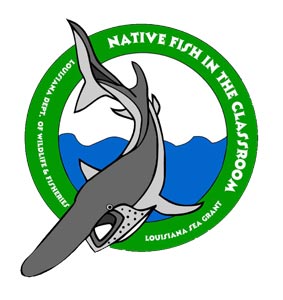Native Fish in the Classroom
What is Native Fish in the Classroom?
Goal:

To assist students in developing an attitude of stewardship toward Louisiana’s natural resources and to provide for them a constructive, active learning situation in which students can explore strategies for sustaining our aquatic ecosystems.
Objectives:
- Provide students in grades 6th through 12th with background information on fisheries management, fish biology, protected species, and aquatic natural resources.
- Maintain a classroom-based nursery aquarium in which students grow native, Louisiana fish, paddlefish, from eggs to fingerlings.
- Produce paddlefish that can be used by the Louisiana Department of Wildlife and Fisheries’ Booker Fowler Fish Hatchery to help manage a protected fish population in Louisiana.
- Assist students in developing an attitude of stewardship toward the state’s natural resources. Students will gain awareness of freshwater ecological systems by helping prevent the loss of a protected fish, benefiting the whole freshwater system.
Why paddlefish?
- Paddlefish spawning cycles coincide with the spring semester of school year
- Paddlefish eggs are large enough to view with the naked eye
- They have distinctive life-stages and develop into fingerlings in about a month and a half
- They are a regulated species of conservation concern in Louisiana
- They are a living fossil
How do paddlefish get to the classroom?
- Qualified candidates, who teach 6th through 12th grade students in Louisiana, may apply. However, this program is geared towards science-based content which is aligned to the state standards.
- Candidates will submit an application, attend all workshops, the spawn event, and the release event.
- The candidate’s principal will provide a letter of support for the program through the application process.
- The application period opens in the spring and closes June 30th of each year.
Participation in NFC includes:
- Two training workshops: summer and winter which focus on biology, fisheries management, aquaculture maintenance, importance of native species, and stewardship
- Teacher manual: background information, aquaria setup and maintenance, and lesson plans
- Equipment loaned by LDWF: aquaria setup and supplies
- Support: who to contact for help and trouble-shooting
- Logging classroom hours through an online portal and completing an end of year survey
Schedule:
- July/August: attend orientation workshop
- September: set up tank in classroom and stock with catfish or bluegill
- September-December: continually monitor water quality and tank maintenance
- January/February: pre-spawn workshop
- March: attend spawn event (bring eggs back to school with you)
- March-April: rearing of fish to fingerling size
- April/May: return fingerlings to the Mermentau River Basin in Jennings
For more information, contact:
- Lindsay Seely at (225) 765-2375 or [email protected]
www.wlf.louisiana.gov/page/for-teachers
